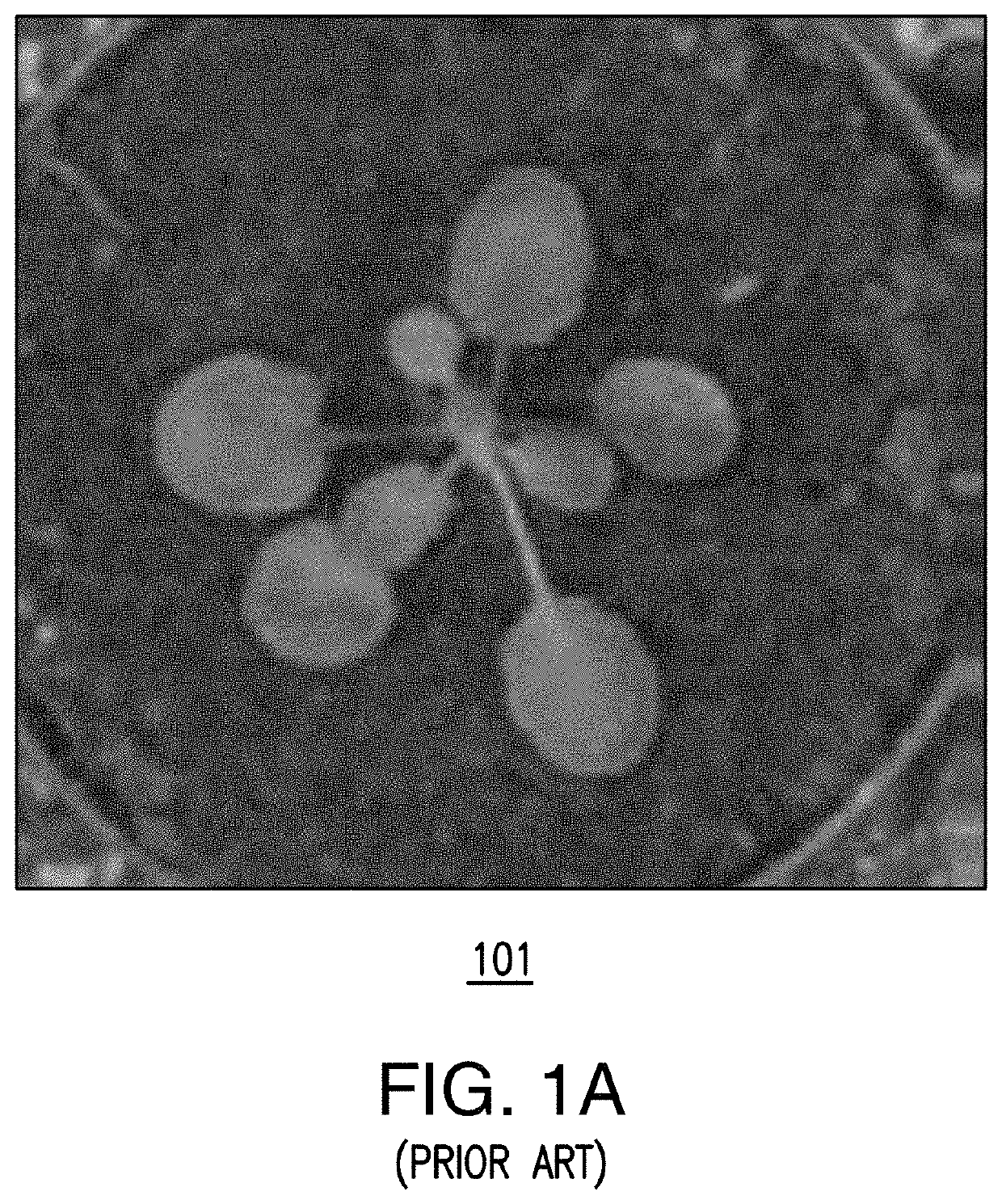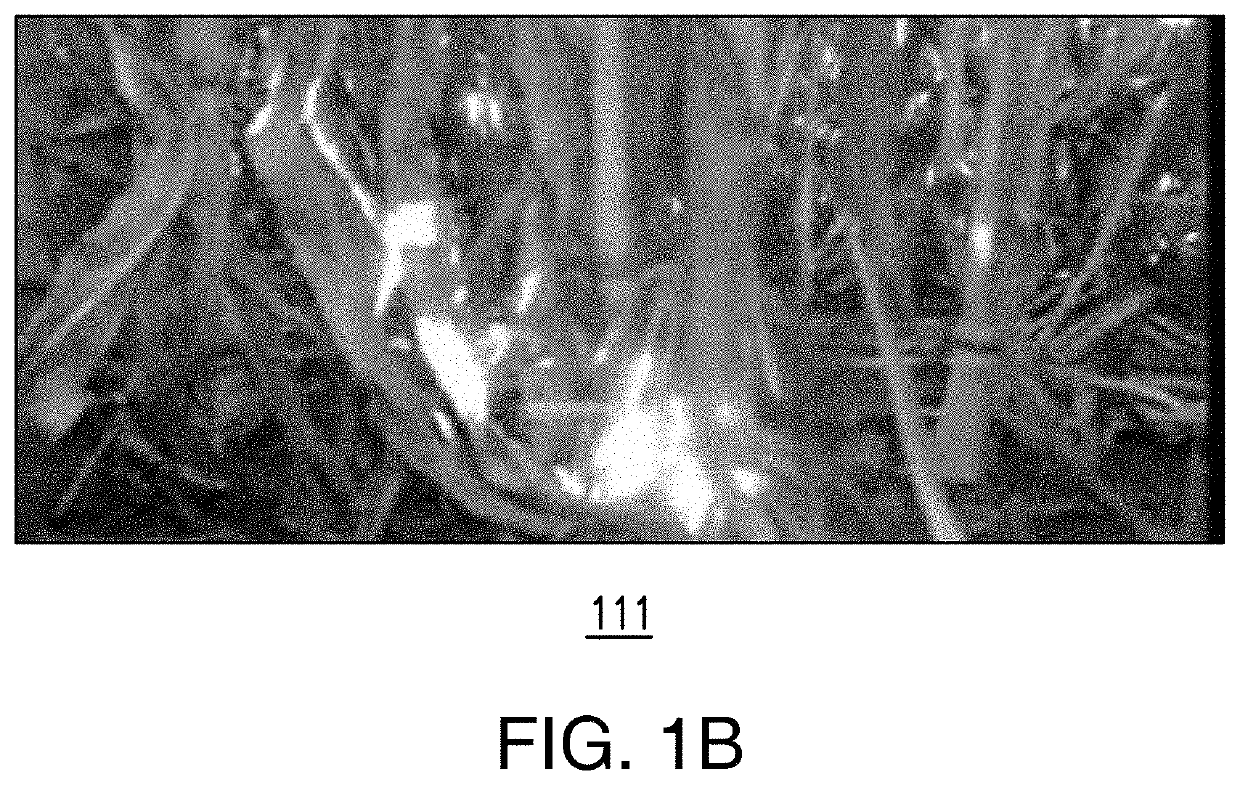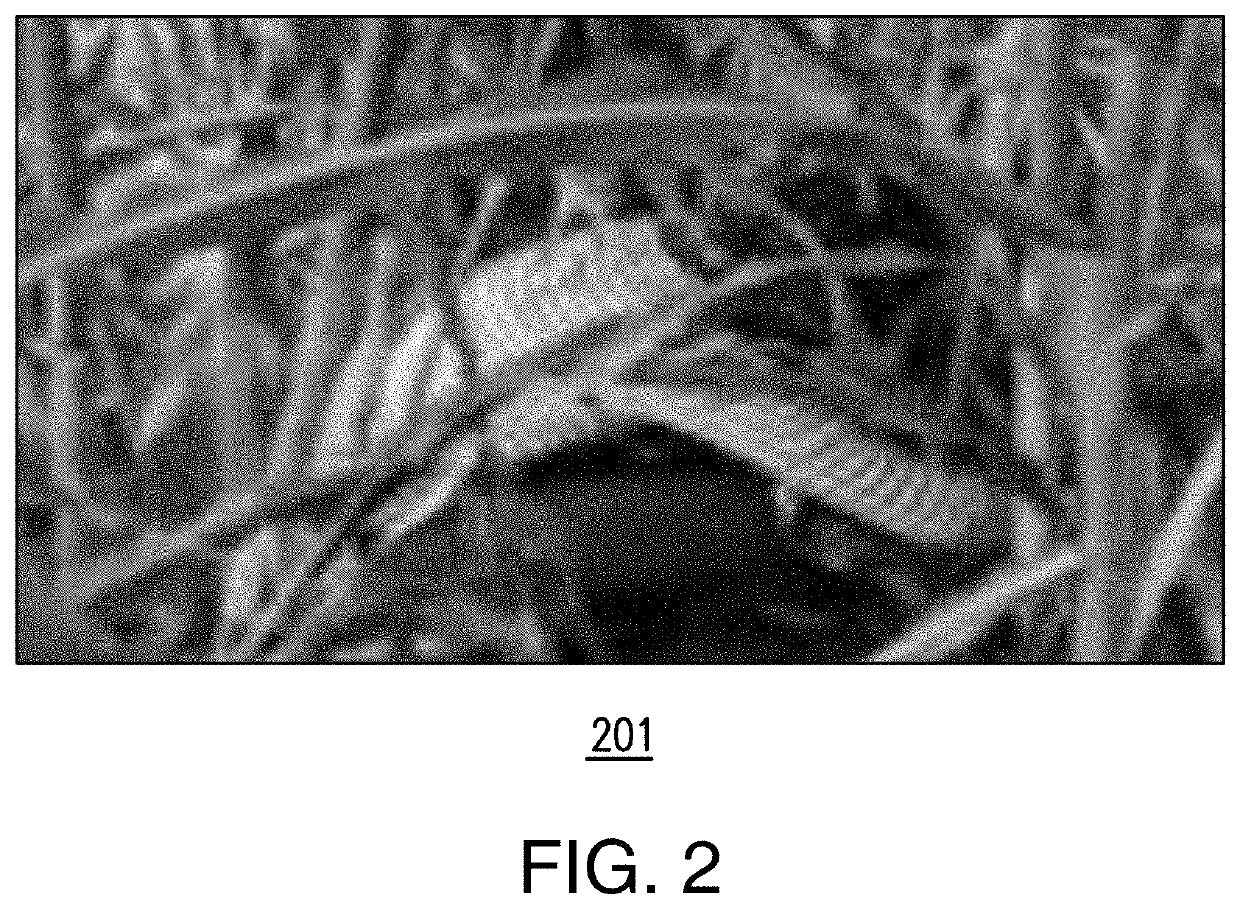However, conventional phenotyping methods are mostly limited to manual measurements out in the field, which is labor intensive,
time consuming, and lacks sufficiency and accuracy.
The aforementioned methods and algorithms have not typically been implemented in actual agricultural fields where the level of uncertainty is very high (e.g., due to changes in lighting conditions during different times of the day and during different seasons, variation of plant color and size across different growth stages, background
clutter, and numerous other factors).
In the context of robotic phenotyping, a challenge is the lack of available labeled and curated datasets for training deep networks in realistic
field conditions.
However, the conditions in this dataset differ significantly from those in the field, with field obtained data from a moving robot having a high level of
clutter, object similarity, varying
sunlight,
motion blur, and occlusions.
In
spite of its importance, it is believed that there are conventionally no efficient in-field practices for stem width measurement.
This technique is slow, inaccurate,
hazard-prone, and highly labor intensive.
However, it is believed that none of these existing width
estimation algorithms have yet been validated in field settings for accuracy and validity under high
clutter and changing
field conditions.
This process is highly labor intensive and prone to errors.
However, the method is not applicable to early growth stages as it is destructive.
[12B] developed an
algorithm for estimating corn plant stand density using aerial hyperspectral imagery, but this method cannot be used in later growth stages, that is, when the
canopy “closes”.
However, these sensors typically do not provide sufficient discrimination between corn and surrounding material, and hence are prone to large measurement errors.
In particular, they cannot easily differentiate between corn leaves, debris, and weeds, which may trigger similar
signal as corn stalks in the measurement.
Hence the studies involving those sensors either were limited to
weed free fields (which is impractical in production fields), or suffered major errors from
weed interference.
However, differentiating corn plants in cluttered agricultural environments in the presence of weeds, overlying leaves, and varying lighting conditions is a highly challenging
machine vision problem.
This
heuristic is highly simplified, and non-robust to real-world conditions, it has therefore (it is believed) only been demonstrated in low-
weed conditions.
However, it is believed that currently no
machine-
vision based (whether utilizing deep-learning or not) corn stand counting
algorithm exists that is robust to real-world
noise, varying lighting conditions, and implementable in real-time on an ultra-compact moving robot.
However, instead of dense
connectivity in fully-connected neural networks, neurons in ConvNets are only connected to a local patch of their predecessors.
If a vehicle / robot /
organism drives / walks / operates over a
crop, it is said to damage the
crop if its activities leave a lasting permanent effect on the plant that affects its health, reduces its yield, or outright kills it.
For example, FIG. 35 shows tire marks in a field that have led to permanent and direct damage due to
heavy equipment passage.
An equipment may also indirectly damage
crop, for example, FIG. 36 shows
soil compaction due to
heavy equipment, which in this case has led to zero yield, but in others can significantly reduce yield.
Further, the lack of low-cost, high-
throughput technologies for field phenotyping is one of the most important hurdles affecting crop breeding.
The inability to collect phenotypic data in a low-cost and reliable manner can create a
bottleneck in seed breeding progress.
This critical gap can significantly hamper agricultural productivity by limiting the breeding of crops with greater yield potential, crops that can effectively
resist abiotic stresses such as heat, drought, flooding etc., and precluding accurate yield prediction.
Collecting these data manually is labor-intensive and expensive.
Skilled and willing agricultural labor is on a decline.
However, these methods have proven difficult to move into fields for high
throughput phenotyping.
However, this method is difficult to move into field settings.
Large scale beam mounted phenotyping platforms are available, however, these systems are very expensive and require quite heavy and elaborate infrastructure.
This makes it impractical for a wide variety of breeders and growers to use these systems.
Large
tractor-mounted equipment or equipment that is mounted on large robots can damage the plant permanently, even killing it, if the
tractor / robot / equipment runs over the plant.
Furthermore, phenotyping typically requires repeated travel through the field multiple times a season; the
heavy equipment (e.g.,
tractor-mounted equipment) can compact the soil, which is undesirable for yield.
Traditionally, these activities are either conducted manually which is labor intensive, or through devices that are pulled by tractors.
However, tractor pulled systems are impractical when crop
canopy grows.
Furthermore, these heavy systems cause
soil compaction which is undesirable for yield.
In addition, these systems can damage plants when they drive over them or
brush against them.
However, systems like the ROWBOT
system can damage plants if they drive over them.
However, the robot does not ensure that crop plants are not damaged during operation or if it drives over them.
In the absence of any major differentiators, farmers are hard pressed to compete on the prices of their products.
As a result, growers are under increasing price pressure.
The cost of a ground-based scouting mechanism includes its manufacturing cost, distribution cost, and operational cost.
The manufacturing cost depends, among other things, on the material it is constructed with, the propulsion mechanism if it is self-propelled, the complexity of actuation mechanism for its turning and traversing the field, and the electronic components it may use.
Heavier robots will typically be more expensive to maneuver, so will be complex robots requiring rack-and-
pinion and other mechanisms to turn.
Heavier robots are also typically difficult to transport, requiring higher transportation and distribution costs.
Heavier robots are also typically expensive to operate, since they can easily damage plants if they run over them, they can also damage property or people if they collide with them, and they require more power to pull their weight, which leads to increased fuel /
electricity costs.
Heavier robots also typically compact soil and damage plants, which will lead to cost due to reduction in yield.
However, aerial scouting only reveals the stress symptoms that are visible from the top of the canopy.
Aerial scouting typically does not reveal under canopy characteristics, nor does it typically reveal minor defects and early indicators of stress on plants, especially when the plants are just emerging and not easily visible in aerial images.
Furthermore, the state of the art aerial drones typically have very limited endurance, especially the multi-rotor type drones (which typically only have an endurance of 10-30 minutes), making it harder for them to cover in detail larger areas.
Furthermore, these robots can be expensive to operate due to regulation, limited endurance, higher cost of manufacturing, and safety.
However, in addition to typically prohibitive costs, these aerial sensors typically do not have sufficient resolution to reveal early indicators of stress.
These aerial sensors typically have limited range, and as such can only be used on low-flying manned or unmanned aircraft, where weight, power, and sensor update-rate typically make it infeasible to use these sensors.
These early indicators are also not typically detectable through aerial scouting.
As a result of the deficiencies of aerial scouting, and the lack of satisfactory scouting ground robots that have low cost and do not damage plants, the prevalent method for agricultural scouting is manual or “on foot” scouting, where a trained agronomist walks through the field.
However, this method of scouting is labor intensive, and can be expensive due to the high costs associated with hiring and supporting agronomists.
Furthermore, wet, muddy fields are infeasible for an agronomist to
traverse, and large fields take a lot of time to
traverse.
In addition, there is no data from field scouting activity other than the qualitative reports provided by the agronomist.
However, there are significant unsolved challenges in robotic season-long agricultural scouting without risking damage to the plants in plurality of crops, geographies, and environments.
Furthermore, emerging agricultural practices such as polycultures or cover-crop lead to agricultural fields that have ill-defined or non-existent rows.
Some farms may not have well defined row spacing if they do not use GPS guided tractors.
However, this robot weighs around 300 lbs. and can significantly damage crop-plants when it drives over them.
It appears that this robot does not ensure that crop plants are not damaged during operation or if it drives over them.
Furthermore, it appears that the robot does not necessarily have the capability to turn around 180° in a row.
There are commercially available rovers that can fit within some crop rows (28-32 inches wide), however, these rovers are not typically designed specifically for agricultural data collection and phenotyping.
However, the Jackal only has about 2.5 inches of ground clearance, this combined with its relatively high platform cost does not make it an acceptable candidate for agricultural scouting.
Husky, is a larger rover from Clear Path, but with a width of 26.4 inches, it is difficult for it to travel comfortably in typical Maize (Corn) crop, and it cannot travel in typical Soybean rows.
Furthermore, the Clear Path rovers do not typically come integrated with sensors and systems required for agricultural scouting tasks, such as automated stand-counting, stalk angle determination, stalk width
estimation, or
biomass estimation.
However, the ROWBOT is heavy, driven by diesel engines, and can permanently damage crops if it drives over them.
It appears that the
system barely fits in rows of corn.
As such, it is not feasible to scout agricultural fields with this
system without risking damage to plants.
However, these types of sensors will not work when the crop-plants are very small.
FIG. 2 depicts an image 201 of an example of a conventional practice of manual stem width measurement using vernier
calipers (this manual practice is typically cumbersome, inefficient, and inaccurate).
FIG. 37 depicts illustrative embodiments of wheels that are not utilized on the robot of FIG. 36 (examples of failed or undesirable wheel designs—from left, too low ground clearance and too much pressure, middle resulted in shoveling of soil and damage to plants, right too much slippage causing damage).
GPS data is also logged, however, GPS accuracy varies widely under canopy, hence
GPS data is not used.
All results discussed herein are in an offline setting with data retrieved using WiFi, however, high speed and low computational requirements of the presented algorithms indicates that in another embodiment they could be utilized onboard the robot.
Morphological Operations: Owing to
noise and variable lighting conditions, the edges obtained in the previous step are often broken.
The SfM problem in
computer vision is the problem of recovering the three-dimensional structure of a stationary scene from a set of projective measurements, represented as a collection of two-dimensional images, via estimation of motion of the camera.
Manual measurements are typically limited by cost and time considerations.
The width estimates are within the expected ranges, however, a rigorous establishment of the
ground truth on these crops was not performed due to lack of manual resources.
17Ashows a situation where even manual classification of the image for stem or leaf is difficult.
In this case, only the partial contour is taken into account, leading to faulty width estimation.
Another drawback of using
deep learning is that the algorithms become crop specific, thereby losing generality, unlike the approaches described herein.
Stem width is an important
phenotype needed by breeders and plant-biologists to measure
plant growth, however, its manual measurement is typically cumbersome, in-accurate, and inefficient.
Such variations make it difficult for classification using conventional approaches.
However, this is not enough to count plants from a moving robot since it is difficult to distinguish different corn plants to avoid double-counting.
Due to the use of depth-wise separable
convolution that uses between 8 to 9 times less computation than standard
convolution, the model runs significantly faster than its more complicated counterparts with only slight accuracy compromise.
It is noted that even for such a compact architecture, it still takes an enormous amount of data to
train the model as it contains 4.2 million parameters.
However, there does not exist such a dataset specifically for
agriculture.
In practice, however, cases arise where class-conditional distributions may overlap, and exact separation of the training data may lead to poor generalization.
Therefore it will likely underestimate the
population to take the number of plateaus as the count.
Pre-specified GPS-paths cannot guarantee the best
quality data collection.
For example, some farms use furrowed
irrigation (i.e., U-shaped depressions, rather than flat ground, between plant rows), which leads to
camera orientation oscillating unpredictably around the optimal during the run.
The challenge here is in determining in the most efficient manner whether or not the image has the desired features that are needed.
The most general approach is the classifier-based approach, wherein the potential challenge is in determining whether or not the classifier in itself is sufficiently confident.
A major error source was dangling leaves covering the
camera lens which caused the algorithm of this embodiment to be more prone to underestimate the
population.
Although the
deep learning algorithm can correctly recognize stalks from leaves, it does not possess the power of making reliable predictions when the
camera lens suffers from heavy
occlusion.
In one or more embodiments, an
agricultural robot is manufactured and / or operates with a low cost for robotic scouting, phenotyping, and / or crop-management tasks, which can be significant given the cost pressure faced by farmers.
GPS-guided tractors and harvesters that can follow prescribed paths are being commercially adopted by growers, however, automating large equipment only partially addresses
robotics challenges in
agriculture, especially since large equipment typically cannot be used when the crop canopy closes.
Agricultural robots out in the market are typically significantly heavier.
However,
metal is heavy and expensive.
Additive manufacturing creates complex designs by layering material, as opposed to traditional
metal working, or traditional injection molding of plastics.
The left most wheel failed because of low ground clearance and too much pressure on the soil.
The middle wheel failed due to too much soil disturbance and damage to plants due to sharp edges (leading to excessive pressure).
The right wheel failed because of too much slippage due to lack of traction causing damage.
The damage to plants was measured by visible damage, the ability of the plant to spring up after robot driving over, and whether the plant thrived in days after the driving event.
These other robots / vehicles resulted in
soil compaction and much deeper
tread-marks than the embodiment of the robot disclosed herein since none of these other robots / vehicles are designed to drive over plants without damaging them (unlike the embodiment of the robot disclosed herein).
In practice, varying soil conditions can result in off-track navigation due to unknown soil traction coefficients.
However, it is not capable of dealing with constrained nonlinear systems.
The traction parameters estimates can play a vital role for the 3D printed robot, and there exist constraints on these parameters, which makes
Extended Kalman filter inconvenient for this system.
 Login to View More
Login to View More  Login to View More
Login to View More 


